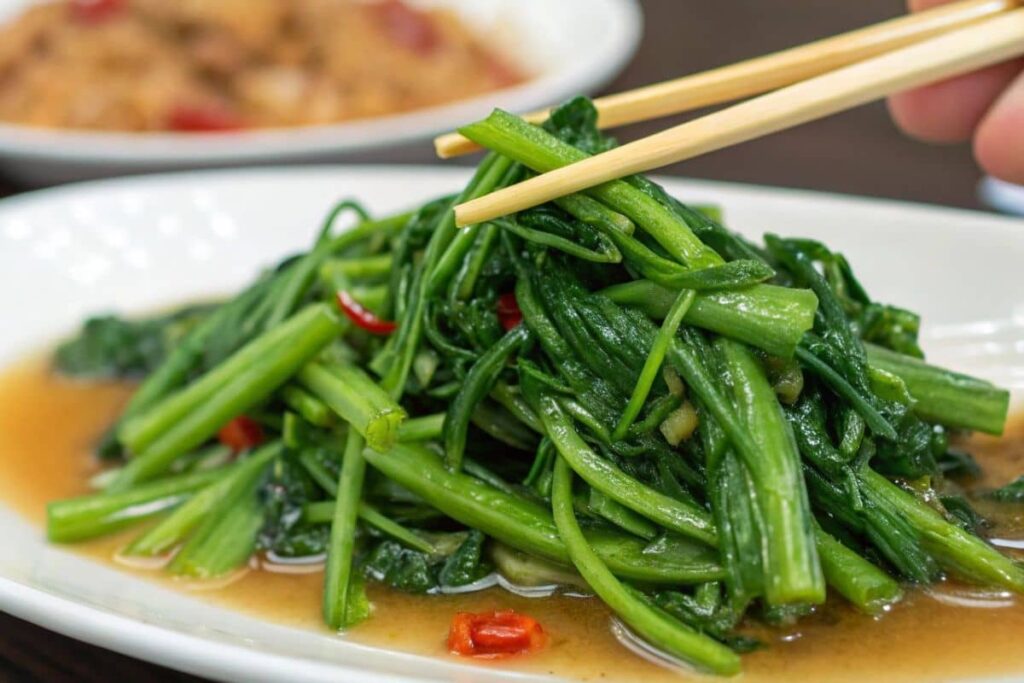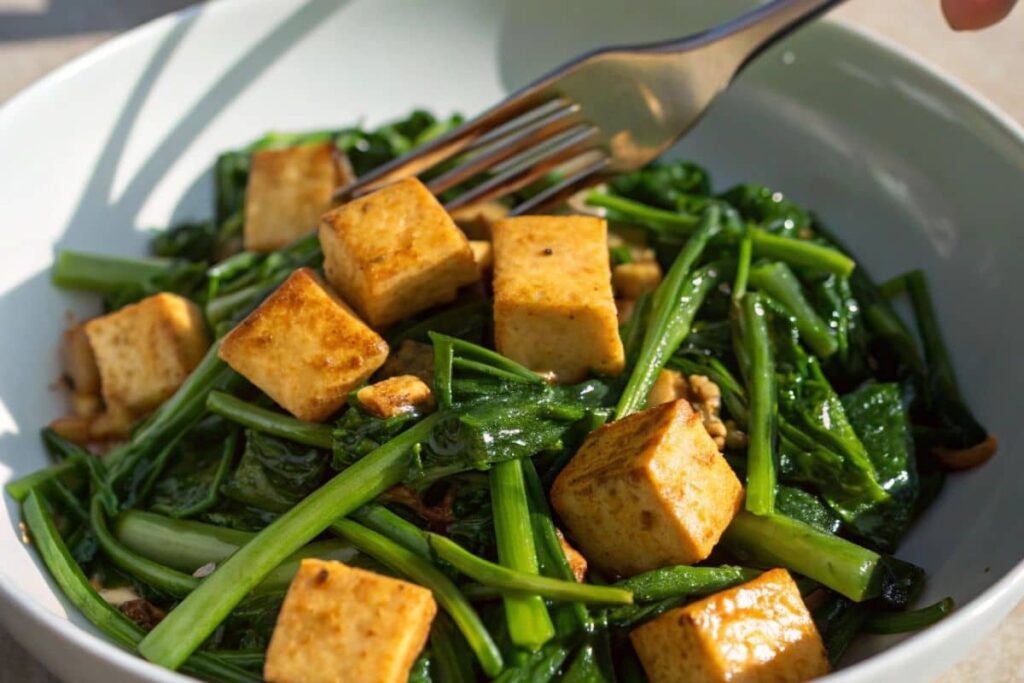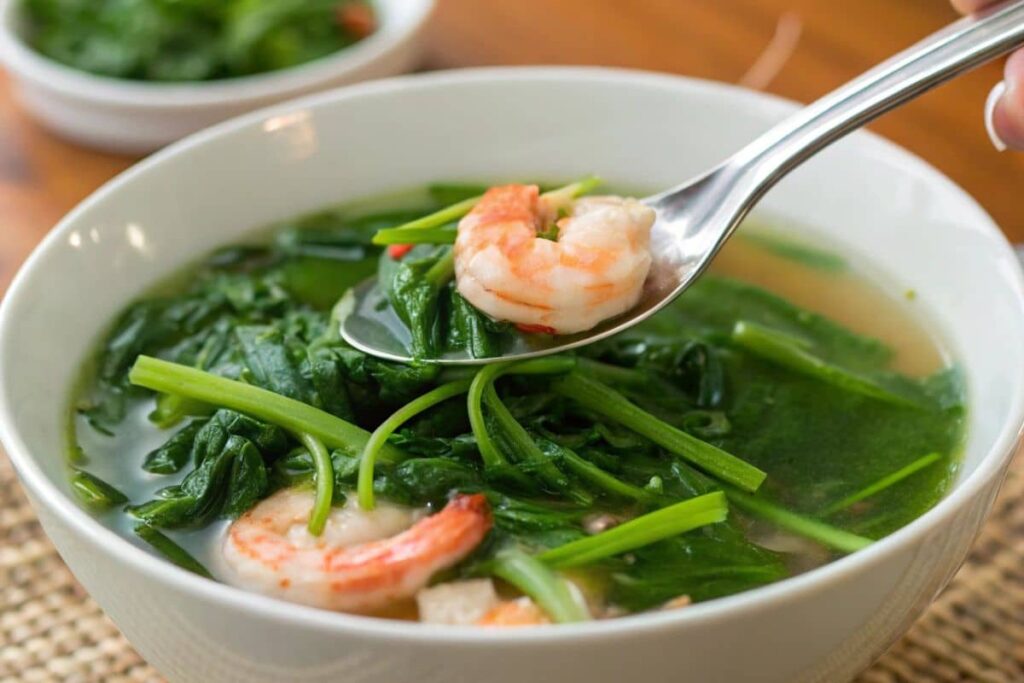In the leafy green showdown, water spinach and regular spinach both claim nutritional superstar status, but they’re actually quite different plants with their own unique benefits. Despite the similar names, these two greens offer distinct flavors, cooking possibilities, and health perks that set them apart.
As more of us embrace plant-powered eating, it’s worth asking: which of these green contenders truly deserves the top spot in your shopping cart? Let’s dive into what makes each of these spinach varieties special, so you can decide which one belongs on your plate for your specific health goals and taste preferences.

What Makes Water spinach Different?
First, let’s clarify the basics, also known as Ipomoea aquatica, thrives in tropical climates and loves water, hence the name. You might know it as kangkung in Southeast Asia. On the other hand, regular spinach, or Spinacia oleracea, is a cool-weather plant and a staple in salads, smoothies, and everything in between.
Quick Comparison Table
| Feature | Water Spinach | Regular Spinach |
|---|---|---|
| Texture | Crisp stems, tender leaves | Soft and delicate leaves |
| Flavor | Mild, slightly earthy | Fresh, slightly bitter |
| Growing Conditions | Tropical, wet environments | Cool, temperate climates |
Nutritional Differences: Which Is Healthier?
Both greens pack a nutritional punch, but their benefits differ slightly. Here’s the breakdown:
Nutrition Facts
| Nutrient | Water Spinach (100g) | Regular Spinach (100g) |
|---|---|---|
| Calories | 19 | 23 |
| Vitamin A | 6300 IU | 9377 IU |
| Iron | 1.2 mg | 2.7 mg |
| Calcium | 77 mg | 99 mg |
| Fiber | 2.1 g | 2.2 g |
Which One Wins?
If you’re all about boosting eye health, regular spinach takes the crown with its higher Vitamin A content. But if you’re looking for a low-calorie green with a unique crunch, water spinach is your new best friend. Isn’t it amazing how each has its strengths?
Taste and Texture: What Sets Them Apart?
Ever wondered why one type of spinach is a staple in stir-fries, while the other shines in salads? It’s all about the taste and texture.
Crisp vs. Tender: The Difference in Bite
The variety often used in Asian dishes has crunchy stems and tender leaves, making it perfect for quick cooking. Its mild flavor pairs beautifully with garlic and chili. Imagine biting into a juicy, crisp stem that absorbs all the delicious sauce, mouthwatering!
Traditional spinach, on the other hand, has a delicate texture with a fresh, slightly bitter taste. It’s ideal for raw salads or lightly sautéed with olive oil. Think of it as the elegant, refined option among leafy greens.
Culinary Uses: How Do They Compare?
Both types of greens are incredibly versatile, but they shine in different dishes.
Cooking with Crunchier Greens
This crisp-stemmed variety is a superstar in Asian cuisine. It’s commonly stir-fried with garlic, tossed into soups, or added to spicy sambal dishes. The stems retain their texture even after cooking, giving dishes an irresistible crunch.
Cooking with Traditional Spinach
The softer variety wilts quickly, making it ideal for creamy dips, pasta dishes, and omelets. It’s also a smoothie hero, toss in a handful, and you won’t even taste it, but you’ll get all the nutritional benefits!
Which Is More Versatile?
It’s hard to pick a winner! The crisp-stemmed option excels in bold, flavorful dishes, while the softer variety is perfect for delicate and versatile preparations. Honestly, why choose? Both bring something special to the table.
3 Delicious Water Spinach Recipes to Try Today!
1. Stir-Fried Water Spinach with Garlic
A quick and flavorful recipe that’s perfect for busy weeknights.
Ingredients:
- 300g water spinach, washed and trimmed
- 4 cloves garlic, minced
- 2 tbsp vegetable oil
- 1 tbsp soy sauce
- 1 tsp oyster sauce
- 1/2 tsp sugar
- Salt to taste
Instructions:
- Heat the vegetable oil in a large skillet or wok over medium heat.
- Add the minced garlic and stir-fry until fragrant (about 30 seconds).
- Increase the heat to high, then add the water spinach. Toss quickly to coat it in the oil.
- Stir in the soy sauce, oyster sauce, sugar, and a pinch of salt. Cook for 2-3 minutes until the water spinach wilts slightly but remains crisp.
- Serve hot as a side dish or over steamed rice.

2. Water Spinach and Tofu Stir-Fry
A vegan-friendly dish packed with protein and fresh greens.
Ingredients:
- 250g water spinach, washed and cut into 2-inch pieces
- 200g firm tofu, cubed
- 3 tbsp vegetable oil
- 1 red chili, sliced (optional)
- 2 cloves garlic, minced
- 1 tbsp soy sauce
- 1 tbsp hoisin sauce
- 1/2 tsp sesame oil
Instructions:
- Heat 2 tablespoons of oil in a skillet over medium heat. Add the tofu cubes and fry until golden on all sides. Remove and set aside.
- In the same skillet, heat the remaining oil and sauté the garlic and chili until fragrant.
- Add the water spinach and toss for a minute.
- Stir in the soy sauce, hoisin sauce, and sesame oil. Toss everything together until the water spinach is tender.
- Return the tofu to the skillet, mix well, and serve warm with rice or noodles.
3. Water Spinach Soup with Shrimp
A comforting and nutritious soup with a hint of seafood flavor.
Ingredients:
- 200g water spinach, washed and cut into pieces
- 200g shrimp, peeled and deveined
- 1 tbsp vegetable oil
- 1 small onion, finely chopped
- 2 garlic cloves, minced
- 1.5 liters chicken or vegetable broth
- 1 tbsp fish sauce
- Salt and pepper to taste
Instructions:
- Heat the oil in a pot over medium heat. Sauté the onion and garlic until translucent.
- Add the shrimp and cook until they turn pink.
- Pour in the broth and bring it to a boil.
- Add the water spinach and season with fish sauce, salt, and pepper. Simmer for 3-4 minutes until the spinach is tender.
- Serve hot as a starter or a light main course.

Health Benefits of Leafy Greens: A Nutrient Showdown
Both of these greens are packed with essential vitamins and minerals, but each offers unique health perks. Let’s explore how they contribute to overall well-being and why they deserve a place on your plate.
Nutritional Power of This Tropical Green
This widely used variety is loaded with antioxidants like lutein, which supports eye health. It’s also a great source of Vitamin C, helping to strengthen the immune system. Plus, its high fiber content promotes healthy digestion, making it a valuable addition to any balanced meal.
Health Perks of Traditional Spinach
This well-known leafy green is packed with iron, making it a great option for those needing an energy boost. Its high magnesium content supports muscle and nerve function, while Vitamin K plays a crucial role in bone health. Plus, the antioxidants found in this vegetable may help reduce inflammation.
Which Is Better for Weight Loss?
Both greens are excellent choices for maintaining a healthy weight. They’re low in calories yet rich in fiber, keeping you satisfied for longer. However, if you’re looking for the lightest option, the tropical variety has slightly fewer calories, perfect for those extra calorie-conscious days!
Growing Water Spinach vs. Growing Regular Spinach
Thinking of starting a garden? These greens are a joy to grow, but they have different needs. Let’s compare!
Which Is Easier to Grow?
If you live in a tropical or humid climate, water spinach is your go-to green. It loves wet conditions and can even thrive in waterlogged soil. Meanwhile, regular spinach prefers cooler weather and well-drained soil. Think of them as nature’s seasonal buddies, one for summer, one for spring.
Climate and Soil Preferences
Water spinach thrives in temperatures between 75–95°F (24–35°C), making it a summer favorite. Regular spinach, on the other hand, grows best between 50–70°F (10–21°C). If you’re a first-time gardener, consider your local weather before picking your plant.
Common Challenges
- Water Spinach: Watch out for pests like caterpillars and snails, they love munching on those juicy leaves!
- Regular Spinach: Be cautious of bolting (when the plant flowers too early) in warm weather. Nobody wants bitter spinach!
Environmental Impact of Cultivating Water Spinach and Regular Spinach
Ever wondered about the environmental footprint of your greens? Let’s dive into how these plants impact the planet.
Sustainability of Water Spinach
Water spinach is often grown in wetland areas, which require fewer chemical fertilizers and pesticides. Its rapid growth rate makes it a sustainable option for farming.
Environmental Concerns with Regular Spinach
Regular spinach, while nutritious, can be resource-intensive to grow. It needs well-drained soil and often requires more fertilizers and pesticides to thrive, especially in large-scale farming.
Cost and Availability: Which Spinach Is Easier to Find?
Now, let’s talk about convenience. Which green is easier to get your hands on?
Where to Buy Water Spinach
Water spinach is commonly found in Asian markets and specialty stores. If you live in tropical areas, you might even see it growing wild! But outside of those regions, it can be tricky to find.
Accessibility of Regular Spinach
Regular spinach is a supermarket staple worldwide. Whether you want fresh, frozen, or even canned, you’ll find it almost everywhere. Convenience at its finest!
Potential Side Effects and Allergies
As much as we love greens, they’re not for everyone. Here’s what you need to know about possible side effects.
Is Water Spinach Safe for Everyone?
Water spinach is generally safe, but consuming it raw may carry risks if it’s grown in polluted water. Always wash it thoroughly before eating!
Who Should Avoid Regular Spinach?
Regular spinach contains oxalates, which can contribute to kidney stones in susceptible individuals. If you have a history of kidney issues, talk to your doctor before adding too much spinach to your diet.
Water Spinach or Regular Spinach: The Final Verdict
So, which one should you choose? Honestly, it depends on your taste, health goals, and availability. If you want something crunchy and unique, go for water spinach. If you’re looking for a classic, versatile green, regular spinach is your best bet.
“Why not enjoy the best of both worlds? After all, variety is the spice of life!”
Frequently Asked Questions About Water Spinach
Where Can I Find Water Spinach Seeds?
Water spinach seeds are widely available at garden centers, online seed stores, and even specialty Asian markets. These seeds thrive in tropical and subtropical climates, so ensure your growing conditions are suitable before planting.
What Part of Water Spinach Is Edible?
The beauty of water spinach is that almost the entire plant is edible! You can enjoy the tender stems, leaves, and even the hollow stalks. The stems add a delightful crunch to stir-fries, while the leaves are perfect for soups and salads.
Want to learn more? Explore our detailed article on What Part of Water Spinach Is Edible.
What Are the Benefits of Water Spinach?
Water spinach isn’t just tasty; it’s also packed with health benefits. This leafy green is rich in Vitamin A, iron, and fiber, making it great for eye health, digestion, and boosting immunity. Its low calorie count also makes it perfect for weight management.
For a deeper dive, don’t miss our full breakdown on Water Spinach Benefits. While you’re here, check out the amazing benefits of Salmon Roe and the versatility of Beef Bacon.
Conclusion: Picking the Perfect Spinach for You
Both water spinach and regular spinach are nutritional powerhouses that bring their own magic to the table. Whether you’re cooking up a spicy stir-fry or blending a green smoothie, there’s a spinach for every occasion. So, what’s your pick? Let us know in the comments below!






